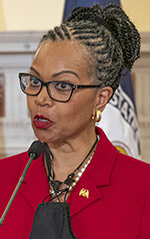DEIA Is No Longer Just “Nice to Have”
A difficult mandate, significant strides, stubborn challenges ahead: State’s first chief diversity and inclusion officer reviews the past two years.
BY GINA ABERCROMBIE-WINSTANLEY
April 12 marked two years since the establishment of the Secretary’s Office of Diversity and Inclusion (ODI) and my appointment as the State Department’s first standalone chief diversity and inclusion officer (CDIO).
On my first day, Secretary of State Antony Blinken made clear that the only way to ensure our foreign policy delivers for the American people is to recruit and retain a workforce that truly reflects the American people. America’s diversity is a source of strength that few countries can match, and it gives us unique advantages on the world stage.
The Secretary asked us to develop a robust framework for fostering diversity, equity, inclusion, and accessibility (DEIA) across the department and noted that the mandate is a hard one: to change parts of the State Department’s culture—the norms, behaviors, and biases—that have prevented equity in career outcomes for far too long.
Over the past two years, the department made significant strides to advance DEIA, but as with any organization, gaps between intentions and outcomes arise. Assigned to lead this tall order, I knew success would not be achieved in a straight line and that we would encounter zigs and zags along the way. For instance, we have identified a range of anomalies in the department’s demographic data that suggests possible barriers to equal opportunity, but we don’t have the resources to study every single anomaly. Instead, we try to identify those areas with the broadest possible enterprise impact and investigate them first.
We also have our work cut out for us in the accountability space. In our May 2022 DEIA Climate Survey, an unacceptably high number of employees reported that they have been the victim of discrimination, harassment, or bullying, but many employees also report that they do not file an official complaint because they either do not think the department would take the necessary corrective action or they fear retaliation. These are two key areas where a lot more work needs to be done.
Solidifying the Foundation
In year one, ODI focused on establishing a solid foundation that would support the DEIA mission for years to come. We made advancing DEIA an agency priority goal in the joint State-USAID overall strategic plan. We negotiated with AFSA to establish advancing DEIA as a precept for Foreign Service officers. Many questioned the need for a stand-alone precept, rather than weaving it in among other “nice-to-haves.” However, advancing DEIA had been part of the precepts for years without resulting in needed change because Foreign Service officers could demonstrate competency in the precept without addressing DEIA. Once we flagged this, we gained the needed support.
DEIA is now a core part of all Civil Service and Foreign Service officers’ work requirements, and for Foreign Service officers it is something that increases their chances for promotion. Every employee benefits from increased inclusion and accessibility, and now every employee gets to do the work. And be rewarded for it.
DEIA is now a core part of all Civil Service and Foreign Service officers’ work requirements.
We established a DEIA Data Working Group, which was charged with the establishment of both a quantitative and qualitative baseline for the department so that future progress could be tracked. I wanted the data disaggregated so that we could really see what was going on and where things might need to be changed to ensure equal opportunity for all.
The “Demographic Baseline Report,” designed to be updated annually, provides every bureau and major office in the State Department a breakdown of its workforce by race, ethnicity, sex, status of disability, grade/rank, and for Civil Service and Foreign Service specialists by job series skill code. The first-year report was posted to our workforce, and in summer 2023, the first two years’ worth of data will be posted not only to our workforce but also to the American people.
On the qualitative side, our team conducted the first-ever DEIA Climate Survey of all U.S. direct-hire employees. That survey, which is only available internally, was vital to identify areas in which there are opportunities for growth, change, and impact. The results were not pretty, particularly, as noted, when it came to reported experiences of bullying or harassment, perceptions of lack of transparency and fairness in the promotion and assignment processes, and perceptions of the department’s interest in holding people accountable.
In March 2022, in response to Executive Order 14035 on advancing DEIA in the federal workforce, we submitted our five-year “DEIA Strategic Plan, 2022-2026” to the Office for Personnel Management (OPM). In September 2022, after OPM had reviewed all agencies’ plans, we rolled out the plan, which outlined and provided a timeline for delivery of more than 200 milestones. We developed an interactive Implementation Dashboard so that employees can track progress toward the goals and objectives envisioned for any given quarter. We also posted the strategic plan on the State Department’s public website—one of only a few government agencies to do so.
With this strong foundation in place, the workforce now expects to see evidence of fewer words and more actions, fewer promises and more impact. And, indeed, we have begun to deliver on impactful change.
More than 20 bureaus have established a position for a DEIA senior adviser to advance DEIA across their respective organizations.
Fewer Words, More Actions
Because diversity diminishes in our more senior positions, the Office of Diversity and Inclusion began examining the policies, practices, and procedures used to select officers for senior positions in the State Department. We found that the deputy assistant secretary positions (slated for Foreign Service officers)—top bureau jobs, and frequently launching pads for chiefs of mission—were not openly advertised and competed. Candidates heard about them with a tap on the shoulder. These jobs are now advertised and competed, a much-needed step toward transparency and fairness.
More than 20 bureaus have established a position for a DEIA senior adviser to advance DEIA across their respective organizations. The DEIA Data Working Group has briefed more than two-thirds of the bureaus on their data, which led many to adjust policies as a result, particularly when it comes to recruitment strategies and how to screen, interview, and select or hire new talent.
The ODI team increased transparency on equal employment opportunity settlement agreements by alerting employees they can speak about aspects of their cases. We support efforts to establish an office focused on stopping bullying and harassment.
Congressional support has allowed the State Department to expand the availability of paid internships, and State is converting all internships to paid internships. State’s first cohort of 126 paid interns was brought on in fall 2022, and we expect to be able to onboard a total of 500 paid interns in Fiscal Year 2023. Recruiting for these opportunities focuses on traditionally underserved communities, socioeconomic groups, and major geographic centers, including minority-serving institutions, women’s colleges, public and land grant universities, and community colleges. The ODI team, including our DEIA Data Working Group, will perform demographic analyses on the intern cohorts to assess if the program does, in fact, enhance department diversity.
Recently, in a move that got widespread press coverage, Secretary Blinken directed the State Department to use a more accessible typeface that is easier to read for colleagues with vision impairments. He elected Calibri (a sans serif typeface) for all papers submitted to the Executive Secretariat. Though a relatively small move, it is a start on addressing the broader issues around accessibility and reasonable accommodations for individuals with disabilities. Our office is also working in collaboration with the Bureau of Medical Services, the Bureau for Global Talent Management, and Diplomatic Security to get medical and lactation devices approved for use within controlled access spaces. Such steps, small or large, create a stronger sense of inclusion and belonging for all.
In March 2023, 16 new demographic questions were added to the State Department’s Global Talent Management database. New questions offer Civil Service and Foreign Service employees expanded options to voluntarily self-identify their sexual orientation; gender identity; disability status; regional origin/heritage; where they are from in the United States; whether they grew up in a rural area, small town, or large city; their educational background; and whether they reside with and/or care for an individual with a disability.
Another continuing challenge is the perception that DEIA is focused on advancing only the interests of racial minorities.
The expansion addresses concerns expressed by employees who do not identify with the current binary gender options “male” and “female.” It will also address concerns of those who are of Middle Eastern and North African heritage and have long lobbied for a “MENA” category. The new questions about where employees spent the majority of their time prior to age 18 and if they lived in a rural area, small town, or large city will allow us to address congressional interest in whether our workforce is drawn from diverse communities and all 50 states. The questions are voluntary, but we encourage employees to answer them, because doing so will give us a much better sense of our overall workforce and any issues particular demographic groups may have.
This summer we will release the results of our first three “barrier analyses”—one on potential barriers for Civil Service progression to the Senior Executive Service, one on mid-level bidding for Foreign Service officers, and one on Civil Service applicant data flow. The last two studies—on FS mid-level bidding and CS applicant data flow—are extremely complex. To assess, for instance, if protected characteristics are a factor in the bidding process, the data group had to control for things like regional experience, language capability, and the rank and cone of the various bidders. The exacting work going into these studies will pay dividends for years to come via interactive dashboards that will allow bureaus to continuously study the makeup of the bidders and applicants for their jobs.
Looking Ahead
I’m proud of what our team has been able to accomplish in two years. We work to ensure that this DEIA push is the last such one the State Department will ever have to do. I say the “last” because, with a sustained effort, we will make sure that, as my friend and fellow DEIA champion Director General of the Foreign Service Marcia Bernicat likes to say, DEIA is part of our institution’s DNA.
To succeed in embedding DEIA in State’s DNA, we will take on some stubborn challenges. I always knew that the accountability piece would be the most difficult, and that has proven true. The Department of State 2022 DEIA Climate Survey revealed widespread employee distrust of how the department handles allegations of harassment, discrimination, and bullying. The ODI team is working with stakeholders throughout the building to fix this.
When the Anti-Harassment Program substantiates harassment, victims are not privy to the details of the findings or recommended solutions; we are exploring ways to address that in keeping with due process and privacy considerations. The ODI team has advocated for stronger consequences for substantiated harassment, discrimination, and bullying, as well as for stronger vetting of candidates under consideration for chief of mission, deputy chief of mission, principal officer, and deputy assistant secretary positions. Those who have a track record of engaging in or tolerating misconduct should not lead our bureaus and missions.
Another continuing challenge is the perception that DEIA is focused on advancing only the interests of racial minorities. We make the case that DEIA benefits everyone: women, racial minorities, those with disabilities, LGBTQI+ individuals, as well as those in the majority in State leadership positions, meaning for the most part straight males of European descent. It takes only a moment to realize not every European American male is part of the “in crowd.” DEIA initiatives help everyone by introducing greater transparency and accountability in our processes.
I will close by noting that we are also living in extraordinarily complex times. If we are to handle the challenges our nation faces with maximum effectiveness, the State Department needs diversity of thought, background, perspectives, and lived experiences at the policymaking table. We need an inclusive workforce, offered equitable opportunities to advance, to ensure our foreign policy is as strong, smart, and creative as it can be.
When sharing or linking to FSJ articles online, which we welcome and encourage, please be sure to cite the magazine (The Foreign Service Journal) and the month and year of publication. Please check the permissions page for further details.
Read More...
- “Creating a Culture of Inclusion at State” by Gina Abercrombie-Winstanley, The Foreign Service Journal, September 2020
- “Diversity and Inclusion in the U.S. Foreign Service—Recommendations for Action” by The Association of Black American Ambassadors, The Foreign Service Journal, January-February 2021
- “The Office of Diversity and Inclusion Turns One: An Interview with Ambassador Gina Abercrombie-Winstanley,” The Foreign Service Journal, June 2022




